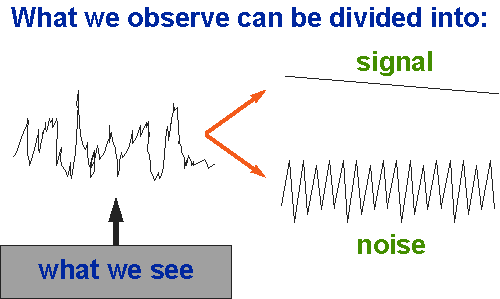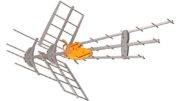The world around us can be separated out into two parts: The things we find important and everything else. We care about our families and friends, our jobs, perhaps the world around us, but there’s plenty of other stuff we don’t care about. Whether that’s a nearby person telling a story we don’t want to hear, the drone of a plane overhead, or a book on a subject we simply don’t care about, we term all of that “noise.” That’s an easy way of thinking about noise — it’s the stuff all around us that we don’t care about but can’t get rid of.
Of course, we’re talking about signals.
On the other hand, the stuff we do want to see and hear, let’s call that “signal.” Signal is the important stuff in your life, the stuff that you need to pay attention to. Sometimes it’s easy to pay attention to, like when your baby cries. That kind of signal is so important that you’re biologically programmed to pay attention. Sometimes it’s harder to understand, like the sound of an upcoming subway stop while riding the “T” in Boston. (Those of you who have done this, you know what I mean.) What’s the difference? Often, it comes down to “signal to noise ratio.”
Understanding signal-to-noise ratio
Signal to noise ratio, often abbreviated SNR, is a mathematical way of understanding the difference between the stuff you want and the stuff you don’t. It usually applies to a radio frequency signal traveling down a wire or over the air. Think about being in a restaurant. A lot of people are talking, so there’s so much noise you need to speak up to be heard. That’s a situation with a “low signal to noise ratio” meaning your voice, the signal, is not much stronger than the noise around it. That’s the opposite of what you want. If you really want to be heard, you want everyone else to stop talking and all the other noise to stop.
In the real world of RF broadcasting, that’s not possible. Noise is everywhere. It’s in the air, it’s part of the very atomic makeup of the cables that signals travel on, and it’s generated by the electronics we use. The best thing we can do most of the time is to limit how much noise our components make because the rest of the stuff is out of our control.
What can you do about noise?
People ask if it’s possible to reduce noise. The answer is, yes and no. It is not technically possible to reduce noise in an electrical system if it’s there other than replacing the component that’s creating it. However it’s possible to increase the signal and hopefully not take too much of the noise with it. A regular amplifier, basically like turning the volume up on your TV, will increase the amount of signal and the amount of noise equally so it won’t necessarily make things better. There are amplifiers designed for digital signals that try to decode the digital signal to an extent and then replicate it, giving you more signal with the same amount of noise.
On the other hand, let’s not forget that electronics themselves create noise. That means it’s possible that the noise you put in can overwhelm the signal you have. In that way it could potentially be worse than not amplifying at all. Although, it’s worth noting that it’s unlikely with quality parts. That’s why you should aim for high quality in an amplifier, unless you don’t care about noise.
Another way of looking at it
Here’s a video by our team that explains in pictures instead of words.
Get the amplifier you need
When you’re ready to shop for an amplifier, check out the great selection at Solid Signal. If you need help choosing one, call our US call center at 888-233-7563.





